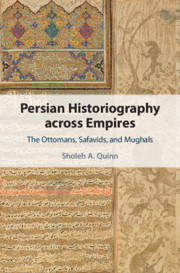Book contents
- Persian Historiography across Empires
- Persian Historiography across Empires
- Copyright page
- Dedication
- Contents
- Tables
- Acknowledgments
- 1 Introduction
- 2 Continuity and Transformation
- 3 Historiography and Historians on the Move
- 4 The First King of the World
- 5 Mirrors, Memorials, and Blended Genres
- 6 Conclusion
- Appendix The Chroniclers and the Chronicles
- Bibliography
- Index
4 - The First King of the World
Kayumars in Universal Histories
Published online by Cambridge University Press: 21 November 2020
- Persian Historiography across Empires
- Persian Historiography across Empires
- Copyright page
- Dedication
- Contents
- Tables
- Acknowledgments
- 1 Introduction
- 2 Continuity and Transformation
- 3 Historiography and Historians on the Move
- 4 The First King of the World
- 5 Mirrors, Memorials, and Blended Genres
- 6 Conclusion
- Appendix The Chroniclers and the Chronicles
- Bibliography
- Index
Summary
Chapter 4 examines one of the most prevalent genres of early modern Persian historical writing:the universal history, which was the most common type of history composed in the early stages of the Ottoman, Safavid, and Mughal dynasties.The chapter focuses on accounts of Kayumars, considered the first human in the ancient Persian tradition. This chapter demonstrates how, while recording the unique aspects of whatever dynasty they were writing under at the end of their universal histories, the chroniclers were predominately narrating a shared past that predated the establishment of Islam. It also establishes that there is no single narrative version that is common to every history, as the chroniclers drew on a range of sources for their information. The choices they made in terms of their sources depended on factors such as regional loyalty and access or family ties.The chapter also demonstrates that many chroniclers looked to the Rawzat al-safa as a model source, and chroniclers writing under Akbar’s reign did not de-mythologize accounts of Kayumars like their Safavid counterparts. In many instances, chroniclers engaged in intertextual dialog as they updated, responded to, and modified their models.
Keywords
- Type
- Chapter
- Information
- Persian Historiography across EmpiresThe Ottomans, Safavids, and Mughals, pp. 107 - 154Publisher: Cambridge University PressPrint publication year: 2020

